 |
 |
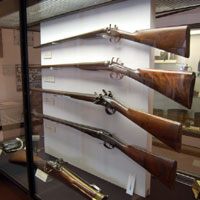
BURY GUNMAKERS
GUNFLINTS AND POWDERHORNS
SOURCES |
The earliest known makers from the St Edmundsbury area are summarised here briefly.
Robert Avery worked in Risbygate Street, Bury. (Risbury St - Johnson)
William Bilson worked at 10 Abbeygate Street, Bury from 1839 to 1844. From 1844 to 1846 the Directories found him at 90 Whiting Street.
William Brewster was recorded at 88 Guildhall Street, Bury St Edmunds, in 1885.
Robert Burrows was recorded as a gunsmith at Bury St Edmunds in 1840.
|
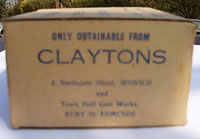 |
Robert Clayton, Bury St Edmunds, 1953-1990s (Also see Scotcher) In the early years of the 20th century the gun sellers business at number 17, The Traverse, was owned by Henry R P Hodgson, whose daughter married H D Bennett in 1913. He ran it from 1916 until 1953. Robert and Violet Clayton took over from 1953 until 1976. They had also opened a branch in Ipswich. In 1976 the business passed to their son Robert Clayton. In 1984 his son Jeremy Clayton joined as a partner. According to the legend upon this empty box of cartridges, Claytons had once referred to their business in Bury as the "Town Hall Gun Works". This name made sense only up until late 1966, when Bury St Edmunds Borough Council Town Hall was located immediately in front of the premises in the Traverse. After December, 1966 the Council moved its council meetings into the Borough Offices extension just completed on Lower Baxter Street, and gave up using the old Town Hall. Nowadays the old Town hall has reverted to being called the Market Cross, and contains commercial premises and the Art Gallery. The Traverse lost its gunshop when Clayton's moved out to 37 Abbeygate Street and began trading as Javelin in the 1990s.
J Furlong, Bury St Edmunds, 1790 J Furlong was recorded as a gunsmith in Churchyard Street, Bury St Edmunds in 1790.
William Golding, Bury St Edmunds, 1770-1823 William Golding was recorded as a gunsmith in London (?) Street, Bury St Edmunds in 1770, and at the same place until 1820. In 1823 he was recorded at Abbeygate Street in Bury.
H Harcourt, Sudbury, 1850 H Harcourt was recorded as a gunsmith in Friar Street, Sudbury in 1850
|
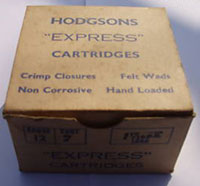 |
Henry R P Hodgson, Bury St Edmunds, 1912-1953 (Also see Scotcher) Henry Hodgson took over the business of John Adam Scotcher, Gunmaker, at 17 Meat Market, which was near the Corn Exchange in Bury St Edmunds. He traded here from 1912 until 1953.Today we know this address as being at 17 the Traverse. This address had been a gunmakers for many years before. Henry R P Hodgson had a daughter who married H D Bennett in 1913. Bennett ran the business from 1916 until 1953. The shop continued to trade as Scotchers for some years, but used the name Hodgsons on their range of gun cartridges. It is not clear when the shop became known as Hodgson's instead of Scotcher's. Robert and Violet Clayton took over in 1953, but the shop still traded as Hodgsons into the 1960s. At present it is unclear to me when the business became called Clayton's. The cartridge range known as Hodgsons continued under that name, sold exclusively in Claytons' shops in Bury and Ipswich.
William Last, Walsham le Willows, 1854-1869 William Last was recorded as a gunmaker, rather than a gunsmith, in Walsham le Willows from 1854 to 1869.
Peter Manning, Lavenham, 1823-1839 Peter Manning was recorded as a "general gunsmith", in Lavenham from 1823 to 1839.
|
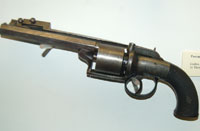 |
Thomas Norfolk, Bury St Edmunds, 1844-1855 Thomas Norfolk was recorded as a gunsmith in 26 Angel Hill, Bury St Edmunds in 1844, and at the Buttermarket in the same year. In 1855 he was recorded at 9 Meat Market in Bury. This revolver was made by him in about 1840, and can be seen in the Moyse's Hall Museum, in Bury St Edmunds. It is .43 calibre, and has a spring bayonet attached, which can be flicked into the ready position when needed. The hammer hits a percussion cap to fire the weapon, and represents a transition between the flintlock and the cartridge with a percussion cap built into it.
Henry Palmer, Bury St Edmunds, 1840 Henry Palmer was recorded as a gunsmith in Bury St Edmunds in 1840.
Benjamin Parker 1783 Derek Johnson recorded a Benjamin Parker, Gunmaker at 30 Churchgate Street, in 1783.
|
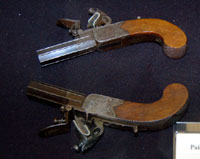 |
Benjamin Parker b1795, fl1823 - 1855 Benjamin Parker's family came from Burgate and had property at Wortham. Benjamin was born on 10th October, 1795, but not baptised until 7th May, 1796 at St Mary's church, in Bury St Edmunds. Derek Johnson recorded a Benjamin Parker, Gunmaker, at 9 Chalk Lane from 1823 to 1839. Benjamin Parker was recorded as a gunsmith in the directories for 1839, 1844 and 1855. His shop was at 30 Churchgate Street in 1839. There are a pair of Parker's pistols on display in Moyse's Hall Museum. Benjamin Parker made a variety of precision objects in addition to his guns. One recorded was a stone-bow, a type of crossbow designed to throw stones or metal shot at game. This would have the advantage of silence, and there were no spent arrows or 'quarrels' to retrieve.
Parker even tried his hand at clockmaking, perhaps inspired by John Pace's success with skeleton clocks.
Haggar and Miller's 1979 Supplement to the Clockmakers of Suffolk, records two 400 day skeleton clocks in his name, and an example of a Parker skeleton clock was sold by Bonhams in September 2005. It was signed on the brass base 'B. Parker, Bury No 132'.
Charles Parker 1823-1839 Charles Parker was at 18 Abbeygate Street, Bury St Edmunds in Pigot's Directory of 1839.
T Parker, Bury St Edmunds 1784 Derek Johnson recorded a T Parker, Gunmaker in Churchgate Street, in 1784.
Thomas Pearsall, Bury St Edmunds, 1770 - 1782 Derek Johnson recorded a Thomas Pearsall, Gunmaker in Cook Row, in 1784.
William Rignall, Hargrave, 1850 William Rignall, described as a Gunsmith and Bell Hanger was located at Market Place, Hargrave, by Derek Johnson.
|
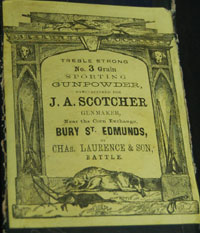 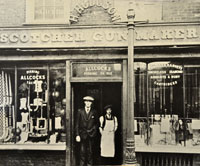 |
John A Scotcher, Bury St Edmunds, 1865-1912 John Adam Scotcher, Gunmaker, had his shop at 17 Meat Market, which was near the Corn Exchange in Bury St Edmunds, from 1865 to 1912. Nowadays we know this address as being in the Traverse. Apparently this address had been a gunmakers for many years before Scotcher took it over. Kelly's Directory of Suffolk for 1900 contained a reference to "Scotcher and Son, gun, pistol and rifle manufacturer, inventor of the 'invincible cartridge' 4 the Traverse." By 1912 the business was owned by Henry R P Hodgson, whose daughter married H D Bennett in 1913. He ran it from 1916 until 1953. Robert and Violet Clayton took over in 1953 until 1976, when it passed to their son Robert Clayton. In 1984 his son Jeremy Clayton joined as a partner. Within living memory the shop was re-named Clayton's Sports Shop, and it still sold a few guns until the 1980s. The Traverse lost a gunshop when Claytons moved out to 37 Abbeygate Street and began trading as Javelin.
John Tickell, Bury St Edmunds, 1775-1793 John Tickell, Gunmaker, was at Bury St Edmunds, from 1775 to 1793.
William Thompson, Hargrave, 1853 William Thompson, described as a Gunsmith was located at Bridge Street, Hargrave, in 1853, by Derek Johnson.
Robert Toope, Bury St Edmunds, 1776 Robert Toope, Gunsmith, was at Bury St Edmunds, in 1776.
|
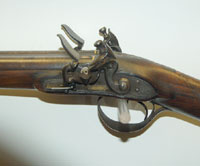 |
William Young (1), Bury St Edmunds, 1823-1855 William Young, Gunsmith, was either one of two men with this name, or he had two shops, overlapping in time at Bury St Edmunds. William Young (1) was located at 17 Meat Market, from 1823 to 1855. William Young (2) was located at 85 Risbygate Street, from 1839 to 1855. Young was a prolific name in Bury gunmaking, with several examples from these shops now to be found in the Moyse's Hall Museum in Bury St Edmunds. This first illustration is of a double barrelled flintlock 12 bore shotgun by William Young of Bury St Edmunds. The flintlock was the earliest type of sporting gun. However, it continued to be produced after newer forms of percussion were invented, because some customers preferred the traditional style over more new-fangled ideas. Moyse's Hall Museum dates this sample to c1800.
|
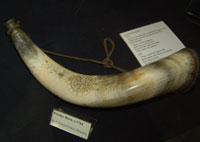 |
NINETEENTH CENTURY GUNFLINT MAKERS In the days when guns were loaded by a separate charge and ball, it was customary to carry the black powder in a powder horn. This horn was made by Nathaniel Drayle of Brandon in 1764. It is on display in Moyse's hall Museum in Bury St Edmunds. Other essential accessories in the days of the flintlock gun, were the flints themselves. Brandon was a centre of flintmaking. Derek Johnson identified a number of 19th century gunflint manufacturers in Thetford Road, Brandon, as follows:
|
|
"Victorian Shooting Days, East Anglia 1810 to 1910", by Derek Johnson, 1981 Information prepared by David Addy, 29th October 2007
|
| Go to Trades and Industries Homepage | Updated 13th May 2009 | Go to Main Home Page |